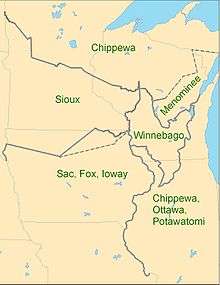First Treaty of Prairie du Chien
The Treaty of Prairie du Chien may refer to any of several treaties made and signed in Prairie du Chien, Wisconsin between the United States, representatives from the Sioux, Sac and Fox, Menominee, Ioway, Winnebago and the Anishinaabeg (Chippewa, Ottawa and Potawatomi) Native American peoples.

The first treaty of Prairie du Chien was signed by William Clark and Lewis Cass for the United States and representatives of the Sioux, Sac and Fox, Menominee, Ioway, Winnebago and the Anishinaabeg (Chippewa and the Council of Three Fires of Chippewa, Ottawa and Potawatomi) on August 19, 1825, proclaimed on February 6, 1826, and codified as 7 Stat. 272.
Due to the overall tribal movements toward the western direction under pressure of encroaching settlers, the Sioux Nation resisted and came into conflict with other tribes moving west into their traditional territory. The United States negotiated the treaty to try to reduce inter-tribal warfare.
The treaty begins by establishing peace between the Sioux and their neighbors: Chippewa, Sac and Fox, and Ioway peoples. The treaty continues by demarcating formal boundaries among each of the tribal groups, often called the "Prairie du Chien Line." For peoples accustomed to ranging over a wide area, the Prairie du Chien Line served as a hindrance, as it provided that tribes were to hunt only within their acknowledged limits. Due to the vast scope of the Treaty of Prairie du Chien and the fact that not all of the necessary tribes had representatives at its signing, the treaty provided for additional councils to be held the following year in 1826 (see Treaty of Fond du Lac). Along with these additional councils, the Chippewa agreed to additional meetings.
The US used the series of Prairie du Chien Lines to serve as the land cession boundaries in later treaties.
See also
- Treaty of St. Louis (1804)
- Treaty of St. Louis (1816)
- Treaty of St. Louis (1818)
- Treaty of St. Louis (1825)
- Treaty of Chicago